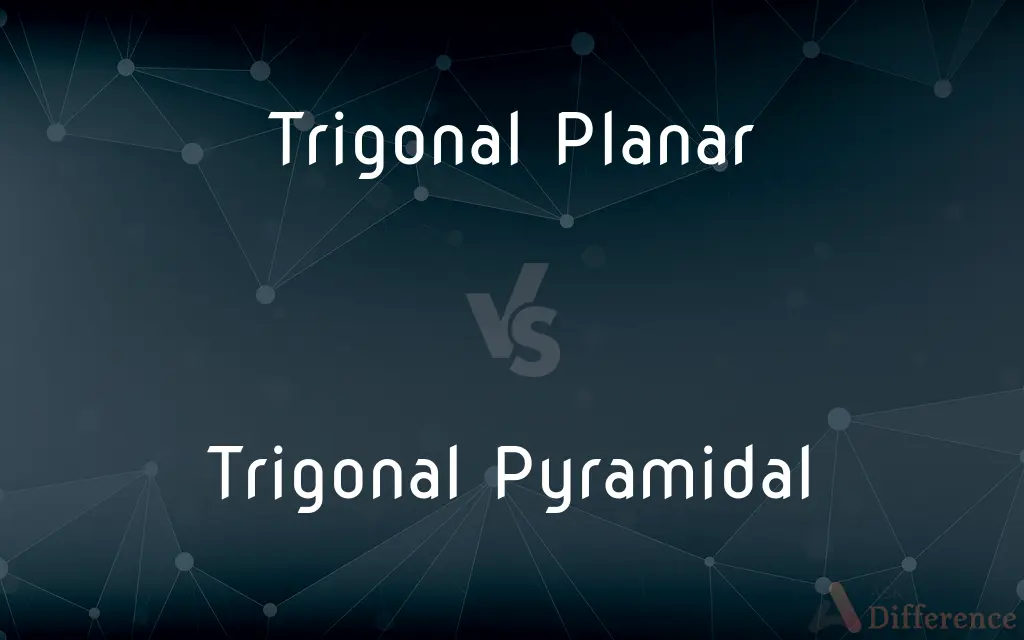Trigonal Planar vs. Trigonal Pyramidal — What's the Difference?
By Tayyaba Rehman — Published on December 7, 2023
Trigonal Planar is a molecular geometry where a central atom is surrounded by three atoms in a plane, forming angles of 120° between them. Trigonal Pyramidal geometry involves a central atom with three bonding pairs and one lone pair (pyramid-like shape).

Difference Between Trigonal Planar and Trigonal Pyramidal
Table of Contents
ADVERTISEMENT
Key Differences
Trigonal Planar and Trigonal Pyramidal: Distinctions start with their basic geometrical layouts. Trigonal Planar showcases a flat, three-sided shape, all bond angles are 120 degrees. Trigonal Pyramidal, however, features a pyramid-like structure, revealing a non-flat arrangement due to a lone pair of electrons.
Electron Domains: Trigonal Planar generally implies that there are three electron domains around the central atom, all being bonding domains. Trigonal Pyramidal, conversely, typically presents four electron domains: three bonding and one non-bonding, contributing to its three-dimensional form.
Chemical Examples: Boron trifluoride (BF3) is a classic example illustrating Trigonal Planar geometry. For Trigonal Pyramidal, ammonia (NH3) serves as a common example, where nitrogen is centrally positioned, orchestrating a pyramidal structure due to the lone electron pair.
Implications on Polarity: Trigonal Planar geometries often yield non-polar molecules if surrounded by identical atoms. However, Trigonal Pyramidal structures frequently are polar, the asymmetry from the lone pair creates a net dipole moment, inducing polarity.
Hybridization Aspect: Trigonal Planar geometry aligns with sp2 hybridization, involving the blending of one s and two p orbitals. Trigonal Pyramidal, with its additional lone electron pair, often exhibits sp3 hybridization, combining one s and three p orbitals.
ADVERTISEMENT
Comparison Chart
Molecular Geometry
Flat, three-sided shape
Three-dimensional pyramid
Bond Angles
Typically 120°
Typically < 109.5°
Number of Bonded Atoms
3 bonded atoms
3 bonded atoms
Lone Pairs on Central Atom
None
1 lone pair
Electron Domains
3 electron domains
4 electron domains (3 bonding, 1 lone pair)
Polarity
Generally non-polar (unless bonds are different)
Generally polar due to the lone pair causing asymmetry
Grammatical Structure
Adjective (descriptive)
Adjective (descriptive)
Number of Syllables
5 (Tri-go-nal Pla-nar)
6 (Tri-go-nal Py-ra-mi-dal)
Term Length
15 characters
17 characters
Word Origin
"Trigonal" from the Latin word "trigonum" meaning "triangle" + "Planar" from the Latin "planus" meaning "flat"
"Trigonal" from the Latin word "trigonum" + "Pyramidal" from the Greek word "pyramis" meaning "pyramid"
Compare with Definitions
Trigonal Planar
Trigonal Planar structures generally present an equal distribution of charge, often yielding nonpolar molecules.
In SO3, sulfur trioxide, the sulfur atom adopts a Trigonal Planar arrangement and the molecule is nonpolar.
Trigonal Pyramidal
Trigonal Pyramidal geometry describes a molecule with a pyramid-like shape formed by three atoms and a lone pair around a central atom.
Ammonia (NH3) forms a Trigonal Pyramidal configuration, with nitrogen at the apex.
Trigonal Planar
Molecules with a Trigonal Planar geometry ensure that all substituents are in a single plane.
COCl2 displays Trigonal Planar geometry, with all atoms residing in one plane.
Trigonal Pyramidal
In Trigonal Pyramidal structures, the bond angles between the atoms are typically less than 109.5° due to lone pair repulsion.
In NF3, the fluorine atoms and the lone pair on nitrogen exhibit Trigonal Pyramidal geometry.
Trigonal Planar
Trigonal Planar denotes a molecular shape that involves sp2 hybridization.
In formaldehyde (CH2O), the carbon atom showcases Trigonal Planar geometry.
Trigonal Pyramidal
Molecules with Trigonal Pyramidal geometry commonly exhibit sp3 hybridization in the central atom.
PH3 has a Trigonal Pyramidal structure due to the sp3 hybridization of phosphorus.
Trigonal Planar
Trigonal Planar connotes an electron-domain geometry where all domains are bonding.
Carbonate ion (CO3^2-) demonstrates a Trigonal Planar structure around the central carbon atom.
Trigonal Pyramidal
The Trigonal Pyramidal form implies an electron domain geometry with three bonding domains and one non-bonding domain.
In H2O, the oxygen atom adopts a Trigonal Pyramidal geometry due to two lone pairs and two hydrogen atoms.
Trigonal Planar
A molecule exhibiting Trigonal Planar geometry has a central atom coordinated by three atoms arranged symmetrically at 120° angles.
BF3 has a Trigonal Planar structure due to its symmetrically arranged fluorine atoms.
Trigonal Pyramidal
Trigonal Pyramidal structures often confer polar properties to a molecule due to the asymmetry induced by the lone electron pair.
The lone pair on the sulfur atom in SOCl2 creates a Trigonal Pyramidal shape and molecular polarity.
Common Curiosities
Can Trigonal Planar and Trigonal Pyramidal structures be polar?
Trigonal Planar structures are typically nonpolar if symmetric, whereas Trigonal Pyramidal structures tend to be polar due to the asymmetry created by the lone pair.
Which bond angles are associated with Trigonal Planar and Trigonal Pyramidal structures?
Trigonal Planar geometries exhibit 120° angles, while Trigonal Pyramidal geometries have slightly less than 109.5° due to lone pair-bond pair repulsion.
Provide a basic chemical example for Trigonal Planar and Trigonal Pyramidal.
BF3 demonstrates Trigonal Planar geometry, while NH3 exemplifies Trigonal Pyramidal.
What is the hybridization state of the central atom in Trigonal Planar and Trigonal Pyramidal geometries?
Trigonal Planar usually exhibits sp2 hybridization, while Trigonal Pyramidal generally showcases sp3 hybridization.
How does electron domain theory describe Trigonal Planar and Trigonal Pyramidal?
Trigonal Planar has three bonding electron domains, whereas Trigonal Pyramidal features three bonding and one non-bonding electron domain.
Are all atoms in the same plane in Trigonal Planar and Trigonal Pyramidal geometries?
In Trigonal Planar, all atoms are in the same plane; in Trigonal Pyramidal, they are not due to the lone pair causing a three-dimensional shape.
Do Trigonal Planar and Trigonal Pyramidal structures exist for larger molecules?
Yes, Trigonal Planar can be observed in larger aromatic compounds, while Trigonal Pyramidal can exist in larger molecules with suitable central atoms.
What’s a key factor determining the shape in Trigonal Pyramidal geometry, not present in Trigonal Planar?
Trigonal Pyramidal is significantly influenced by the lone electron pair, which is absent in Trigonal Planar geometries.
What primarily differentiates Trigonal Planar from Trigonal Pyramidal geometries?
Trigonal Planar geometry involves three atoms evenly spaced around a central atom, while Trigonal Pyramidal includes three atoms and a lone electron pair around the central atom, causing a pyramid-like shape.
How does lone pair repulsion vary between Trigonal Planar and Trigonal Pyramidal molecules?
Trigonal Planar structures exhibit no lone pair repulsion between adjacent atoms, while Trigonal Pyramidal experiences repulsion due to the lone pair distorting bond angles.
Are Trigonal Planar and Trigonal Pyramidal geometries related to VSEPR theory?
Absolutely, VSEPR theory helps predict both Trigonal Planar and Trigonal Pyramidal shapes based on electron domain repulsions.
How do molecular orbitals differ between Trigonal Planar and Trigonal Pyramidal molecules?
Trigonal Planar molecules possess overlapping p orbitals, while Trigonal Pyramidal molecules often exhibit hybrid orbitals created from both s and p orbitals.
Can resonance structures influence Trigonal Planar geometries more than Trigonal Pyramidal?
Yes, Trigonal Planar structures, especially in polyatomic ions, may involve resonance, while Trigonal Pyramidal geometries are less impacted by resonance due to their lone pair.
How do electronic configurations affect Trigonal Planar and Trigonal Pyramidal shapes?
Trigonal Planar usually forms from a central atom with an s and two p orbitals, while Trigonal Pyramidal generally results from a central atom using an s and three p orbitals.
How does molecular symmetry compare between Trigonal Planar and Trigonal Pyramidal?
Trigonal Planar geometries typically express high symmetry, while Trigonal Pyramidal structures have less symmetry due to the lone electron pair.
Share Your Discovery

Previous Comparison
Yankees vs. Mets
Next Comparison
Balance Sheet vs. Cash Flow StatementAuthor Spotlight
Written by
Tayyaba RehmanTayyaba Rehman is a distinguished writer, currently serving as a primary contributor to askdifference.com. As a researcher in semantics and etymology, Tayyaba's passion for the complexity of languages and their distinctions has found a perfect home on the platform. Tayyaba delves into the intricacies of language, distinguishing between commonly confused words and phrases, thereby providing clarity for readers worldwide.
















































